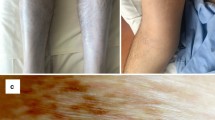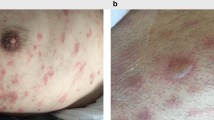Abstract
We describe a patient with severe Shulman’s syndrome (ShS) (eosinophilic fasciitis). This auto-immune disease involved not only the skin and muscles, but the bone marrow as well – thereby fulfilling the criteria of severe aplastic anemia. As the disease was steroid-resistant, the patient underwent allogeneic bone marrow transplantation (BMT). Remission of ShS was achieved. Eight months later chronic GVHD developed and relapse of ShS (probably induced by GVHD) occurred. He was successfully treated with corticosteroids and the disappearance of GVHD was followed by cessation of the symptoms of ShS. At present (34 months following BMT) he is doing well and displays no signs of ShS or GVHD. This case suggests that an aggressive immunoablative preparative regimen with subsequent allogeneic BMT can result in long-lasting clinical remission of a severe auto-immune disease.
Similar content being viewed by others
Author information
Authors and Affiliations
Rights and permissions
About this article
Cite this article
Cetkovský, P., Koza, V., Cetkovská, P. et al. Successful treatment of severe Shulman’s syndrome by allogeneic bone marrow transplantation. Bone Marrow Transplant 21, 637–639 (1998). https://doi.org/10.1038/sj.bmt.1701137
Received:
Accepted:
Published:
Issue Date:
DOI: https://doi.org/10.1038/sj.bmt.1701137
- Springer Nature Limited
Keywords
This article is cited by
-
Morphea and Eosinophilic Fasciitis: An Update
American Journal of Clinical Dermatology (2017)
-
D-penicillamine in the treatment of eosinophilic fasciitis: case reports and review of the literature
Clinical Rheumatology (2012)
-
Eosinophilic fasciitis associated with autoimmune phenomena after bone marrow transplantation: report of two cases
Clinical Rheumatology (2006)
-
Clinically demonstrable anti-autoimmunity mediated by allogeneic immune cells favorably affects outcome after stem cell transplantation in human autoimmune diseases
Bone Marrow Transplantation (2002)




